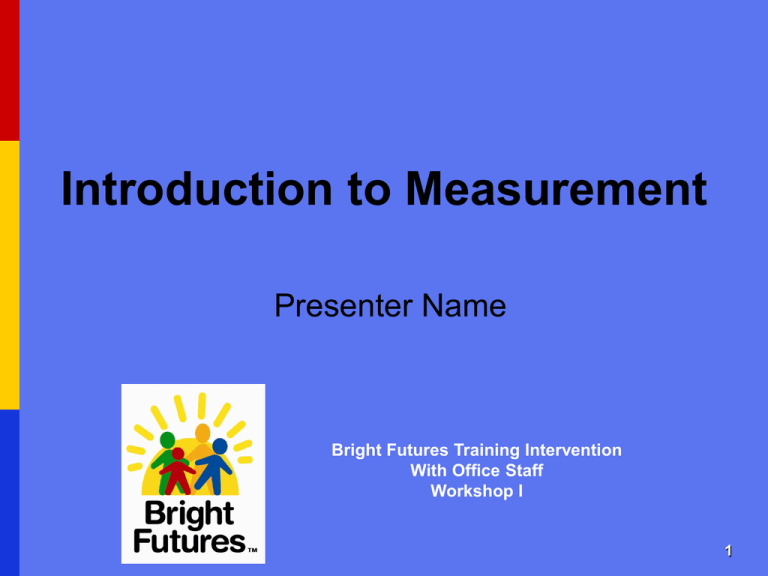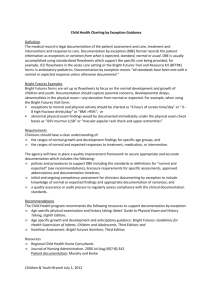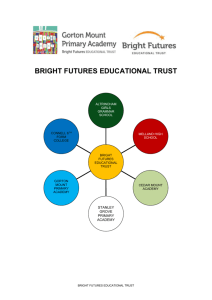Measure - Bright Futures
advertisement

Introduction to Measurement Presenter Name Bright Futures Training Intervention With Office Staff Workshop I 1 Session Objectives Describe importance of measurement and general principles of measurement for improvement. Discuss measurement strategy for Bright Futures. Gain familiarity with one Bright Futures data collection tool. Review Plan-Do-Study-Act cycles and describe role of measurement within them. 2 Why Measure? “All improvement is change, but not all change is an improvement.” Need measures to know if we are reaching our Aims. 3 Key Principles of Improvement Measurement Focus on a few measures (usually 5-7). Keep it simple and easy. Integrate measurement into daily routine. Consecutive sampling. Use existing data when possible. Plot data over time. 4 Measurement for Improvement IS Designed to help your team and other teams learn. Like a growth curve: it’s not where you are, but where you are going. IS NOT Designed for criticism or punishment. Supposed to end (it should be sustainable). 5 Measurement for Research Versus Improvement Research Generate new knowledge. Single test. Need to collect all possible data “just in case.” Improvement Put new ideas into practice. Many sequential tests. Collect “just enough data.” 6 Bright Futures Core Measures Global project measures Overall results related to project Aim Based on 6 components of Bright Futures framework 7 Core Measure 1 Bright Futures component: Use of preventive services prompting sheet Measure: Percent of well-child visits of children younger than 5 years in which a preventive services prompting sheet is used 8 Core Measure 2 Bright Futures component: Use of structured developmental assessment Measure: Percent of well-child visits of children younger than 5 years in which Ages and Stages or Parents’ Evaluation of Developmental Status is used to evaluate development and behavior 9 Core Measure 3 Bright Futures component: Evaluation of parental strengths and needs Measure: Percent of well-child visits of children younger than 5 years in which parent strengths and needs are assessed 10 Core Measure 4 Bright Futures component: Development of recall and reminder system Measure: Score on recall and reminder items on practice team survey 11 Core Measure 5 Bright Futures component: Development of linkages to community resources Measure: Score on community resource linkage on practice team survey 12 Core Measure 6 Bright Futures component: Identification of children with special health care needs Measure: Percent of well-child visits of children younger than 5 years in which there is documentation that provider asked about special health care needs 13 Measurement Tools Chart review Practice team survey (Bright Futures Office Systems Inventory) 14 Team Measurement Exercise: Completing the Bright Futures Office Systems Inventory 15 Additional Measures Pilot refinement measures Volume 1: Improving Preventive Care in Your Office: Tools for Office Improvement usefulness Volume 3: Training Materials to Improve Preventive Care in Office Practice: Bright Futures Workshop Materials usefulness Balancing measures Cycle time (average number of minutes in office per patient 16 Creating Your Practice’s Own Additional Measures Measure only the things you need to know. Make sure they are related to your Aim and goals. Create a Measurement Plan for each additional measure. 17 Sources of Additional Measures Your team members. Other teams. Goals in your Prework. Think of “balancing measures.” 18 Balancing Measures Don’t want to improve one part of system at the expense of others. Think of potential unintended consequences and parts of your system distant to the area you are trying to improve. Example: patient flow may be affected by changes to preventive visit content—measure cycle times. 19 Create a Measurement Plan Clarify the data collection goals. Develop procedures for each additional measure. How is it defined? What data will be collected? On which patients? How will the data be collected? Who will collect the data? When? 20 For Each Additional Measure Carefully define numerator and denominator. Begin tracking measures immediately and gather historical (baseline) data, if available. Develop run charts to display your measures each month (use paper/pencil or Excel). 21 Using Measures: Annotated Run Charts Clinician education Practice wide guidelines Reminder system 22 Measurement of Plan-Do-Study-Act Cycles 23 24 Global Project Measures Versus Plan-Do-Study-Act (PDSA) Measures Global Project Measures: Overall results related to the team Aim (core measures and teams’ additional balancing measures) PDSA Measures Quantitative data on the impact of a change Qualitative data to help refine the change 25 Measurement for Plan-Do-Study-Act (PDSA) Cycles “Study” is specific to the PDSA cycle. Usually not one of core measures Usually begins and ends with PDSA cycle Often qualitative Identify/create tools to be used for data collection—make it simple and easy. 26 Use the Plan-Do-Study-Act Cycle for Testing or adapting a change that relates to project goals Implementing a change 27 Multiple Plan-Do-Study-Act Cycles Help Achieve Project Goals 28 Summary Measurement for improvement is simpler and more focused than research. Measurement is necessary to assess success and track progress. Usually need 5 to 7 measures to ensure that the system is improved. Practices are encouraged to add a few additional measures, including balancing measures. Practices complete data collection and team status reports monthly. 29











